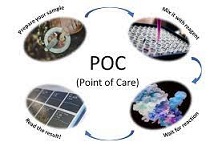Point of Care (POC) for Early Infant Diagnosis (EID) in Nigeria? Healthcare Workers Opinion

Abstract:
Without access to life-saving
drugs, including antiretroviral, about one-third of HIV exposed infants (HEI) will
die by age 1 year and 50% by age 2 years. A 75% reduction in disease progression
and 76% reduction in HIV mortality in infants has been attributed to early diagnosis
of HIV and early commencement on ART. Early Infant Diagnosis (EID) of HIV aids timely
commencement on antiretroviral therapy (ART). Several challenges have been identified
with the current process. Point of care (POC) technologies are recommended as a
veritable means of addressing these challenges and improving EID uptake. With the
aim of assessing the standard of care and the acceptability of POC for the provision
of EID. A descriptive cross-sectional survey was conducted across eight healthcare
facilities in Nigeria. The survey was conducted among 72 healthcare workers using
self-administered questionnaire; with a recovery rate of 61(84.7%). Analysis of
participants’ responses indicate that 100% of the respondents believes there is
a need for EID. Most respondent reported an average turnaround time (TAT) of 3-4
weeks (35.8%) and >6 weeks (34.0%). Most respondents identified distance to the
PCR laboratories (45.7%) and long TAT (34.8%) as key issues affecting the conduct
of EID. On the benefit of POC for EID; 90.2% of respondent believe it is beneficial;
while 81.5% of respondent believe that with the introduction and use of POC for
EID there will be an increase in EID uptake. The POC is a viable and acceptable
alternative for EID to increase uptake.
References:
[1]
WORLD HEALTH ORGANIZATION (WHO). Global Programme on AIDS,
1988. WHO Report Breastfeeding, breast milk and human immunodeficiency virus (HIV).
Statement from the Consultation held in Geneva, 23-25 June, 1987. AIDS Action, (5), 1–2. Date of Access: 05/05/2020.
https://pubmed.ncbi.nlm.nih.gov/12281628/.
[2]
UNAIDS Data 2019. Date of Access: 06/05/2020 https://www.unaids.org/sites/default/files/media_asset/2019-UNAIDS-data_en.pdf.
[3]
WORLD HEALTH ORGASNIZATION, 2011. The interagency task
team on the prevention and treatment of HIV infection in pregnant women, mothers
and children (IATT) Annual meeting report (2-3 May 2011), Geneva, Switzerland).
Date of Access: 01/03/2020.
https://apps.who.int/iris/bitstream/handle/10665/44637/9789241501927_eng.pdf;jsessionid=92F8E333FD82CE0F5BE7461D59C7F1C7?sequence=1.
[4]
Anisa Ghadrshenas, Yanis B. Amor, Joy Chang, Helen Dale.
et. al. 2013. Improved access to early
infant diagnosis is a critical part of a child-centric prevention of mother-to-child
transmission agenda. AIDS 2013, 27 (Suppl.
2): S197–S205. Date of Access: 13/03/2020
https://journals.lww.com/aidsonline/Fulltext/2013/11002/Improved_access_to_early_infant_diagnosis_is_a.8.aspx.
[5]
Carlucci, J. G., Liu, Y., Friedman, H., Pelayo, B. E.,
Robelin, K., Sheldon, E. K., Clouse, K., & Vermund, S. H. 2018. Attrition of
HIV-exposed infants from early infant diagnosis services in low- and middle-income
countries: a systematic review and meta-analysis. Journal of the International AIDS Society, 21(11), e25209. Date of Access:
15/5/2020 https://doi.org/10.1002/jia2.25209.
[6]
Udochisom C. Anaba, Nadia A. Sam-Agudu, Habib O. Ramadhani,
Nguavese Torbunde, Alash’le Abimiku, Patrick Dakum, Sani H. Aliyu, Manhattan Charurat,
2019. Missed opportunities for early infant diagnosis of HIV in rural North-Central
Nigeria: A cascade analysis from the INSPIRE MoMent study. PLoS ONE. Date of Access: 15/5/2020. https://doi.org/10.1371/journal.pone.0220616.
[7]
Isah HO, Ogum E, Cornelius LJ, Okundaye JN, Galadanci
H, Charurat ME, et al. 2014. The MoMent Study: Client‐ and Community‐Level Barriers
to PMTCT Access and Uptake in Rural North‐Central Nigeria. 8th INTEREST (International
Workshop on HIV Treatment, Pathogenesis, and Prevention Research in Resource-Poor
Settings) Workshop; Lusaka, Zambia. p. 45. Date of Access: 15/5/2020. http://regist2.virology-education.com/abstractbook/2014_3.pdf.
[8]
WORLD HEALTH ORGANIZATION (WHO) The treatment 2.0 framework
for action: catalysing the next phase of treatment, care and support. (2011). The
World Health Organization (WHO) publication 2011. Date of Access: 03/05/2020. https://apps.who.int/iris/bitstream/handle/10665/44640/9789241501934_eng.pdf;jsessionid=01FAF23E05BA02AA84E195D24277E22D?sequence=1.
[9]
Schito M, Peter TF, Cavanaugh S, Piatek AS, Young GJ,
Alexander H, Coggin W, Domingo GJ, Ellenberger D, Ermantraut E, Jani IV, Katamba
A, Palamountain KM, Essajee S, Dowdy DW. 2012. Opportunities and challenges for
cost-efficient implementation of new point-of-care diagnostics for HIV and tuberculosis.
J Infect Dis. 2012 May 15; 205 Suppl 2():
S169-80. Date of Access: 29/06/2020. https://academic.oup.com/jid/article/205/suppl_2/S169/805866.
[10] Urdea M, Penny LA,
Olmsted SS, Giovanni MY, Kaspar P, Shepherd A, Wilson P, Dahl CA, Buchsbaum S, Moeller
G, Hay Burgess DC, 2006. Requirements for high impact diagnostics in the developing
world. Nature. 2006 Nov 23; 444 Suppl
1():73-9. Date of Access: 29/06/2020. https://www.nature.com/articles/nature05448.
[11] Burgess DCH, Wasserman
J, Dahl CA, Girosi F, Olmsted SS, Keeler EB, et al. 2007. Estimating the Global
Health Impact of Improved Diagnostic Tools for the Developing World. Santa Monica,
CA: RAND Corporation; 2007. Date of Access: 29/06/2020. http://www.rand.org/pubs/research_briefs/RB9293.html.
[12] Jani IV, Meggi B,
Loquiha O, et al. Effect of point-of-care
early infant diagnosis on antiretroviral therapy initiation and retention of patients.
AIDS. 2018;32(11):1453‐1463. doi:10.1097/QAD.0000000000001846.
[13] Flavia Bianchi, Jennifer
Cohn, Emma Sacks, Rebecca Bailey, Jean-Francois Lemaire and Rhoderick Machekano.
2019. Evaluation of a routine
point-of-care intervention for early infant
diagnosis of HIV: an observational study in eight African countries. The Lancet HIV Volume 6, Issue 6, June 2019,
Pages e373-e38. Date Accessed: 15/5/2020. https://doi.org/10.1016/S2352-3018(19)30033-5.
[14] Pharr, Jennifer
R., Obiefune, Michael C.; Ezeanolue, Chinenye O.; Osuji, Alice; Ogidi, Amaka
G.; Gbadamosi, Semiu, Patel, Dina, Iwelunmor, Juliet; Yang, Wei; Ogedegbe,
Gbenga; Ehiri, John E.; Sam-Agudu, Nadia A.; Ezeanolue, Echezona E. 2016.
Linkage to Care, Early Infant Diagnosis, and Perinatal Transmission Among
Infants Born to HIV-Infected Nigerian Mothers: Evidence from the Healthy
Beginning Initiative, JAIDS Journal of Acquired Immune Deficiency Syndromes:
August 1, 2016 - Volume 72 - Issue - p S154-S160. Date of Access: 5/04/2020.https://doi.org/10.1097/QAI.0000000000001051.

